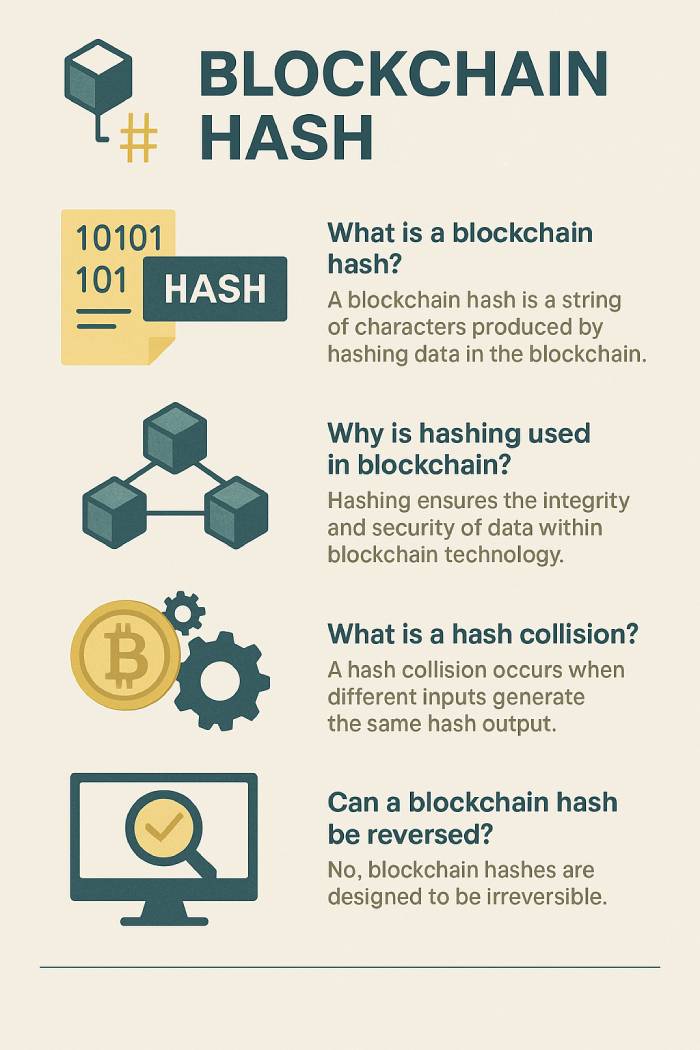Understanding Hashing in Blockchain Technology

A cryptographic hash function is one of the core building blocks of blockchain technology. It’s a mathematical operation that takes input data—known as a "message"—and processes it through a hashing algorithm to generate a unique hash or hash output. This fixed-size string of characters, known as the hash value, plays a crucial role in securing and organizing data in any blockchain network.
What Is a Hash Function in Blockchain?
A hash function processes input of any length and transforms it into a consistent-length hash value. Regardless of whether the input is a short phrase or a massive dataset, the function will generate a hash of a fixed length. This predictability and uniformity help create reliable digital fingerprints.
In modern systems, especially within blockchain networks, these cryptographic hash functions are used to store passwords, verify data, and secure transactions. When you sign up on a website, your password is passed through a secure hash algorithm, and only the hash is stored. Later, the same hashing algorithm is used to verify the password during login.
To further increase protection, platforms often add a random element called a "salt" before hashing. This ensures that identical passwords produce different hashes, thwarting attacks from precomputed rainbow tables.
The Role of Hashing in Blockchain Security
Hashing supports several essential functions in blockchain security:
- Tamper Detection: If any data in a block changes, the hash value also changes. Since each block contains the hash of the previous block, modifying one block affects the entire chain. This ensures any tampering is immediately evident.
- Data Verification: Comparing a block’s current hash output with its original confirms data integrity. In systems like Bitcoin, this helps ensure that blocks remain consistent throughout the entire blockchain network.
- Sequential Linking: Each block stores the hash of the previous block, creating an unbroken chain. This link between blocks allows for a transparent, chronological record of all activity the blockchain contains.
- Proof-of-Work and Consensus: In systems using Proof-of-Work (PoW), miners compete to solve complex puzzles that involve producing a valid hash output. This puzzle must meet specific criteria, and solving it allows miners to add a new block. This maintains decentralization and ensures that no single party controls the blockchain network.
How the Hashing Algorithm Works
The process of hashing follows these general steps:
- Input Processing: Whether it’s a file, transaction data, or a message, it gets processed through a hashing algorithm.
- Output Generation: The result is a unique hash, a fixed-length digital fingerprint.
- Storage: This hash value is stored with the original data or within the blockchain, serving as a reference to ensure that the data hasn’t changed.
This process also strengthens password systems. A user’s password is hashed, and during authentication, the input is hashed again and compared to the stored hash output.

Common Hashing Algorithms in Blockchain
Several hashing algorithms are used in different blockchain technologies:
- SHA-256 (Secure Hash Algorithm 256-bit): This widely trusted algorithm is used in Bitcoin to produce a 256-bit hash output.
- Scrypt: More memory-intensive than SHA-256, Scrypt is used by Litecoin and other blockchains to prevent attacks from specialized mining hardware.
- Ethash: Ethereum's native algorithm, Ethash, emphasizes memory-hardness to resist ASIC-based mining and increase fairness in block creation.
- Equihash: Used by Zcash, Equihash is another ASIC-resistant algorithm that enhances decentralization.
Each algorithm has its own method of producing unique hashes and plays a key role in ensuring the reliability of the blockchain.
Collision Resistance and the Value of Unique Hashes
A key feature of any cryptographic hash function is collision resistance—the improbability that two different inputs produce the same hash output. For example, SHA-256 generates over 10^77 possible outputs, making it nearly impossible for a different hash to match another.
While it's mathematically possible, the odds of a collision occurring are so low that it's considered practically impossible. This level of assurance supports the security of blockchain systems and maintains the trust in every block the blockchain contains.
Hash Functions Are One-Way and Secure
Hashing algorithms are non-invertible. That means, even if someone knows the hash output, they cannot determine the original input. The only theoretical method to crack it is brute force—trying every combination until a match is found. But even the world’s fastest supercomputers would require an immense amount of time and energy to reverse a single hash value.
This inherent property of hash functions ensures that data remains confidential and trustworthy. The strength and design of these algorithms make them an essential part of cybersecurity and the foundation of blockchain technology.
Pros and Cons of Hashing in Blockchain
Pros:
- High Security: Hash functions provide robust protection for data and prevent unauthorized modifications.
- Efficiency: Fast processing speeds allow for quick data verification and blockchain updates.
- Data Integrity: Easy detection of tampered data enhances trust across the blockchain network.
- Decentralization Support: Proof-of-Work systems rely on secure hashing for consensus mechanisms.
- Privacy: Sensitive data can be securely stored and validated without revealing its content.
Cons:
- Irreversibility: While one-way hashing adds security, it also means that lost data (e.g., passwords) cannot be recovered.
- Computational Costs: Especially in PoW blockchains, hashing demands significant energy and computing power.
- Vulnerability to Brute Force: Although difficult, given enough time and power, hashes can be brute-forced.
- Dependence on Algorithms: If a hashing algorithm is broken or deprecated, systems must transition quickly to maintain security.
- No Built-In Error Correction: Hashing cannot detect or correct accidental data entry errors—it only flags inconsistency.
By weighing these factors, developers and users can better understand the strengths and limitations of integrating hash functions into blockchain systems.
Expert Opinions
According to Dr. Sarah Lin, a cybersecurity researcher at MIT, “Cryptographic hashing forms the backbone of blockchain integrity. Without it, trustless networks wouldn’t be able to verify data in a decentralized manner.”
John Carver, CTO at a leading blockchain firm, adds: “Choosing the right hashing algorithm is not just about security — it’s also about long-term viability. The blockchain ecosystem needs algorithms that are resilient to future threats, especially quantum computing.”
Meanwhile, Sophie Müller, a blockchain educator and author, emphasizes the importance of education: “Many users engage with blockchain daily without fully understanding how hash functions protect their data. Bridging this knowledge gap is essential for mass adoption.”
Conclusion
In conclusion, hashing plays a foundational role in modern blockchain ecosystems, enabling security, transparency, and trust across decentralized platforms. By leveraging cryptographic hash functions, developers can ensure data integrity, build secure authentication mechanisms, and support consensus protocols that keep the blockchain network functional and tamper-resistant. As blockchain technology continues to evolve, mastering the principles of hash functions will remain essential for anyone involved in building, using, or securing decentralized systems.




